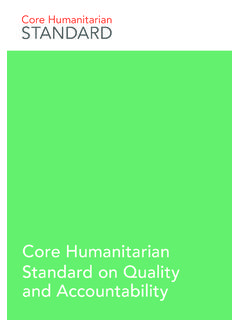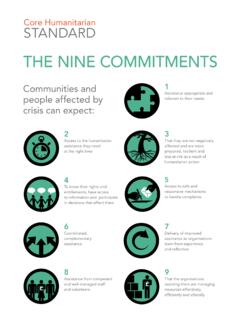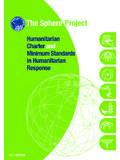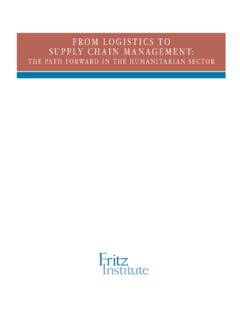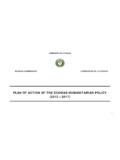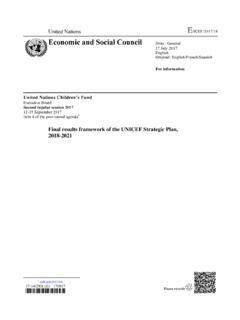Transcription of Core Humanitarian STANDARD
1 CHS guidance notes and IndicatorsCore by CHS Alliance The Sphere Project Groupe URDF irst edition 2015 ISBN: 978-2-9701015-2-9 All rights reserved. The copyright of the material contained herein is held by CHS Alliance, the Sphere Project and Groupe URD. It may be reproduced for educational purposes, including in training, research and programme activities, provided that the CHS guidance notes and Indicators is acknowledged. To translate or adapt all or any part of the CHS guidance notes and Indicators, prior written permission must be obtained by emailing 4 Table of the Nine Commitments and Quality Criteria5 Commitment 18 Commitment 211 Commitment 315 Commitment 419 Commitment 523 Commitment 626 Commitment 729 Commitment 833 Commitment 937 Annex 1: Terms and definitions usedContents2 CHS guidance notes and Indicators The CHS guidance notes and Indicators are a supplement to the core Humanitarian STANDARD on Quality and Accountability (CHS). This document is aimed at all Humanitarian actors and organisations involved in planning, managing or implementing a Humanitarian response, including staff and volunteers of local, national and international agencies.
2 It may also be used by government agencies and local authorities and adapted for use with affected communities. The guidance provides clarification on the Key Actions and Organisational Responsibilities laid out in the CHS and examines some of the practical challenges that may arise when applying the CHS. It explains why each of the Nine Commitments of the CHS is important and provides some examples for different audiences and for different contexts. The guidance does not however provide an in-depth explanation of how to respond to Humanitarian emergencies. It provides instead a list of more detailed guidance on how to meet each Commitment. While each Commitment focuses on a discrete area of Humanitarian action, there is necessarily some degree of overlap that binds the Commitments together into a coherent whole. For example, the importance of communication with crisis-affected communities and people and the supportive management of staff run through all Nine Commitments.
3 The prevention of sexual exploitation and abuse, and the importance of transparency are also relevant to several of the and diversity. The CHS promotes fundamental human rights and is underpinned by the right to life with dignity, and the right to protection and security as defined in international law. The CHS recognises that the participation of crisis-affected people is the cornerstone of an effective Humanitarian response. To this end, it is vital to acknowledge diversity within communities by collecting and using data disaggregated by sex, age and ability to inform programmes. This will help to ensure the different needs of various groups are met by giving them a say in the decisions that shape the response. In this document, community is understood as a group made up of women, men, boys and girls, each with different capacities, needs and [vulner] performance indicators and guiding questions are intended to promote measurement of progress towards meeting the STANDARD and to drive continuous learning and improvement in the quality and accountability of Humanitarian responses.
4 Some organisations may wish to develop tools to enable the comparison of results across different organisations, contexts and time. The performance indicators and guiding questions may be applied to guide: project and programme design; monitoring at project, programme, sectoral and response-wide levels; agency-led organisational assessments; capacity-building strategies; internal evaluations; peer and joint reviews and evaluations; and real-time monitoring by affected communities and applying the performance indicators, users are advised to consider the following:Integrity. The performance indicators should be used as a set. They are few in number, relevant to all sectors and contexts, and reflect the need to triangulate information from different sources, including different groups within the affected population. If an organisation decides not to use an indicator , it is encouraged to make the reasons for that decision explicit when reporting on The performance indicators should be adapted to each context- and organisation-specific process.
5 They may be complemented by other appropriate indicators and guiding The performance indicators and guiding questions may be used at all stages of the response, from assessment to evaluation. Measurement. The performance indicators are intended to enable the measurement of progress and/or comparison across time, programmes and contexts. In order to be meaningful and acknowledge the diversity of needs but also satisfaction with ongoing programmes, performance indicators need to be measured in a way that is consistent across time, location, and allows at a minimum to disaggregate data based on age and gender. A simple way to score the performance indicators is to use a 5 degree Likert scale (1=Strongly disagree; 2=Disagree; 3=Neither agree nor disagree; 4=Agree; 5=Strongly agree).Additional guidance . Users are advised to refer to the links below, to the guidance at the end of each section, and to the glossary and footnotes for other useful guidance notes and Indicators The CHS guidance notes and Indicators were developed by a working group made up of representatives of international NGOs, networks, UNOCHA, Groupe URD, the Sphere Project and the CHS Alliance.
6 It has been enhanced through consultation and field-testing involving a wide range of users in different contexts. The CHS management team would like to gratefully acknowledge the financial support the Disasters Emergency Committee made available for the production of the guidance notes and Indicators. The development of the guidance has drawn on existing materials from Sphere, CHS Alliance (formerly HAP and People In Aid) and Groupe URD. The guidance notes and Indicators will be revised based on feedback from users by March 2017 at the latest. Please send any feedback and suggestions to Organisations who are interested in verification against the CHS can refer to the tools available on the CHS Alliance website under to further guidanceADCAP (2015) Minimum standards For Age And Disability Inclusion In Humanitarian Action (Pilot Version): Gender Marker 2013-14: International (2014) Disaster resilience in an ageing world: How to make policies and programmes inclusive of older people : (2014) Methodology - Participative evaluation of accountability to affected populations (Central African Republic): guidance notes and Indicators The Nine Commitments and Quality Criteria1.
7 Communities and people affected by crisis receive assistance appropriate and relevant to their needs. Quality Criterion: Humanitarian response is appropriate and a8 b947561238 a8 b947561239. Communities and people affected by crisis can expect that the organisations assisting them are managing resources effectively, efficiently and Criterion: Resources are managed and used responsibly for their intended a8 b947561237. Communities and people affected by crisis can expect delivery of improved assistance as organisations learn from experience and Criterion: Humanitarian actors continuously learn and a8 b947561236. Communities and people affected by crisis receive coordinated, complementary assistance. Quality Criterion: Humanitarian response is coordinated and complementary. 8 a8 b947561235. Communities and people affected by crisis have access to safe and responsive mechanisms to handle complaints. Quality Criterion: Complaints are welcomed and a8 b947561234.
8 Communities and people affected by crisis know their rights and entitlements, have access to information and participate in decisions that affect them. Quality Criterion: Humanitarian response is based on communication, participation and a8 b947561233. Communities and people affected by crisis are not negatively affected and are more prepared, resilient and less at-risk as a result of Humanitarian action. Quality Criterion: Humanitarian response strengthens local capacities and avoids negative a8 b947561232. Communities and people affected by crisis have access to the Humanitarian assistance they need at the right time. Quality Criterion: Humanitarian response is effective and a8 b947561238. Communities and people affected by crisis receive the assistance they require from competent and well-managed staff and Criterion: Staff are supported to do their job effectively, and are treated fairly and guidance notes and Indicators Commitment 1 Communities and people affected by crisis receive assistance appropriate to their needs.
9 Quality criterion: Humanitarian response is appropriate and is this Commitment important?Commitment 1 captures the primary purpose of responding to Humanitarian crises, which is to alleviate distress and suffering, uphold people s rights to assistance and ensure their dignity as human beings. A response that automatically treats everybody and every situation in the same way may fail to meet its objectives and is unlikely to maximise its potential benefit to those in need. Commitment 1 stresses the importance of understanding the context and the needs of the different people affected and how these needs might change over time as well as the necessity to recognise the capacity of different groups of people. It also highlights the role of policies and processes to drive the ongoing assessment of needs, impartial assistance, and acknowledging gender and diversity in the a8 b94756123 Key ActionsGuidance Conduct a systematic, objective and ongoing analysis of the context and and analysis Assessment and analysis is a process, not a single event and, as time allows, in-depth analysis should be carried out.
10 The needs of affected communities should not be assumed but identified through assessments that engage them in an ongoing discussion to find appropriate responses. It is vital to cross check and verify ( triangulate) information, acknowledging that assessment data will initially be imperfect. An assessment of the safety and security of both disaster-affected and host populations is important to identify threats of violence and any forms of coercion, denial of subsistence or denial of basic human rights. An analysis of gender-related needs also helps to define a more effective and sustainable response. Planning is required to coordinate with others and avoid burdening communities with multiple assessments. Wherever possible, joint assessments (such as the multi-cluster/sector initial rapid assessment (MIRA)) should be carried out and information (including selection criteria) shared with interested agencies, government and affected indicators1. Communities and people affected by crisis consider that the response takes account of their specific needs and The assistance and protection provided correspond with assessed risks, vulnerabilities and The response takes account of the capacities ( the skills and knowledge) of people requiring assistance and/or questions for monitoring Key Actions Has a comprehensive needs assessment been conducted and used to inform response planning?
